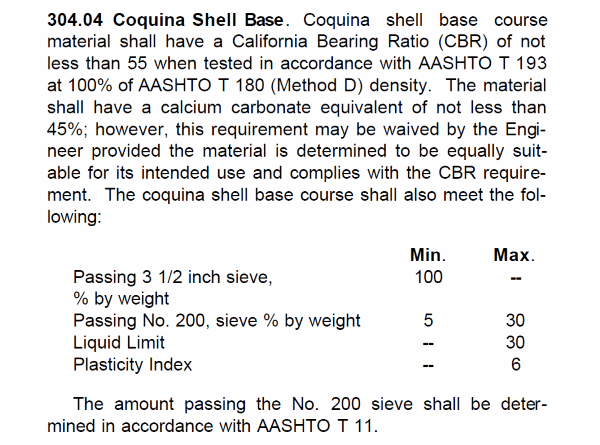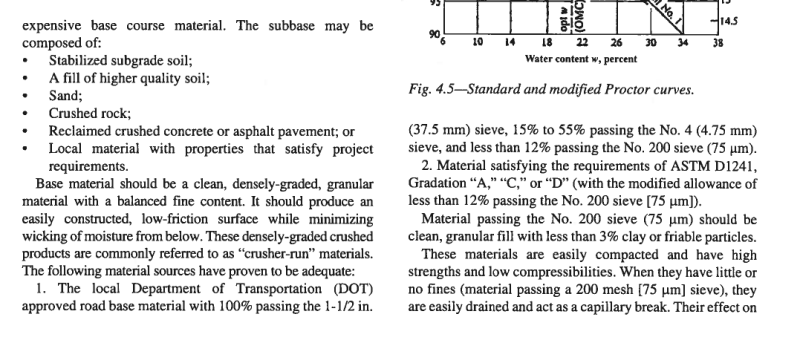Hi, what type of material do you normally use underneath slabs on grade? Open grade gravel or something like base course material for pavements which has some fines for proper compaction? I think that both materials can provide adequate support for the slab but I kind of prefer the later since it can be compacted and tested. What are your opinions?
Navigation
Install the app
How to install the app on iOS
Follow along with the video below to see how to install our site as a web app on your home screen.
Note: This feature may not be available in some browsers.
More options
Style variation
-
Congratulations MintJulep on being selected by the Eng-Tips community for having the most helpful posts in the forums last week. Way to Go!
You are using an out of date browser. It may not display this or other websites correctly.
You should upgrade or use an alternative browser.
You should upgrade or use an alternative browser.
Floor slabs - Gravel base 1
- Thread starter Okiryu
- Start date
- Status
- Not open for further replies.
SlideRuleEra
Structural
Material similar to base course for pavements. In this area that is crushed fossilized limestone which is the most economical anyway.
![[idea] [idea] [idea]](/data/assets/smilies/idea.gif)
![[r2d2] [r2d2] [r2d2]](/data/assets/smilies/r2d2.gif)
![[idea] [idea] [idea]](/data/assets/smilies/idea.gif)
![[r2d2] [r2d2] [r2d2]](/data/assets/smilies/r2d2.gif)
Okiryu....agree with SRE....
You want material that will be a capillary barrier so that water/moisture does not rise greatly through the subgrade into the slab on grade. In order to be a capillary barrier, it should have a fineness modulus no less than about 3.0.
That can be a very clean medium sand to fine gravel, but agree that it should be compactable. Also, make sure you specify good grade control. No more than a 1/2" in 5 feet for flatness and no sudden transitions....otherwise expect more cracking.
You want material that will be a capillary barrier so that water/moisture does not rise greatly through the subgrade into the slab on grade. In order to be a capillary barrier, it should have a fineness modulus no less than about 3.0.
That can be a very clean medium sand to fine gravel, but agree that it should be compactable. Also, make sure you specify good grade control. No more than a 1/2" in 5 feet for flatness and no sudden transitions....otherwise expect more cracking.
- Thread starter
- #4
SRE, Ron, thanks for the replies. In the US, do you have an ASTM designation for that type of material?
Also, could you look at this website (in Japanese) which has photos of different soil material/aggregates and suggest what type of material could be the more appropriate underneath slab on grades?
I vote for C40, M40, open grade material can also work based on Ron's notes about capillary barrier. (if you choose any material which its name is in Japanese, just copy and paste that name in your response).
BTW, are there any recommendations for the maximum amount of fines for capillary barriers?
Also, could you look at this website (in Japanese) which has photos of different soil material/aggregates and suggest what type of material could be the more appropriate underneath slab on grades?
I vote for C40, M40, open grade material can also work based on Ron's notes about capillary barrier. (if you choose any material which its name is in Japanese, just copy and paste that name in your response).
BTW, are there any recommendations for the maximum amount of fines for capillary barriers?
-
1
- #5
SlideRuleEra
Structural
Okiryu - The material we use is defined by a South Carolina Department of Transportation specification. A version of that specification is posted below.
However what we use does NOT technically meet that specification... I'll explain. Limestone quarries sell the specified base course, but they also offer a lower cost product called "ROC" (Run Of Crusher).
To make ROC the quarry starts with the same limestone used for base course.
ROC is crushed with the same equipment that produces base course.
The difference is that ROC is what comes out to the crusher, with no tests performed on it. Without testing or guarantees, ROC is lower cost than base course, but the product is virtually identical.
Large quantities or ROC are use for roads (both paved and unpaved), foundations, building, equipment laydown areas, etc. at our electric generating stations. Soils are typically poor, water table is high, and loads are heavy. ROC is ideal for these applications.

![[idea] [idea] [idea]](/data/assets/smilies/idea.gif)
![[r2d2] [r2d2] [r2d2]](/data/assets/smilies/r2d2.gif)
However what we use does NOT technically meet that specification... I'll explain. Limestone quarries sell the specified base course, but they also offer a lower cost product called "ROC" (Run Of Crusher).
To make ROC the quarry starts with the same limestone used for base course.
ROC is crushed with the same equipment that produces base course.
The difference is that ROC is what comes out to the crusher, with no tests performed on it. Without testing or guarantees, ROC is lower cost than base course, but the product is virtually identical.
Large quantities or ROC are use for roads (both paved and unpaved), foundations, building, equipment laydown areas, etc. at our electric generating stations. Soils are typically poor, water table is high, and loads are heavy. ROC is ideal for these applications.

![[idea] [idea] [idea]](/data/assets/smilies/idea.gif)
![[r2d2] [r2d2] [r2d2]](/data/assets/smilies/r2d2.gif)
- Thread starter
- #8
Guastavino
Structural
CABC stone which is crushed ABC stone. 4"
For my house though, I used 4" washed stone and a 15 mil Stego vapor barrier...I spec 10 mil for commercial...so I overkilled the house a little bit...
I will say this though, I personally watched a concrete bucket truck spin tires on a stego 15 mil for 45 minutes and it didn't tear...
For my house though, I used 4" washed stone and a 15 mil Stego vapor barrier...I spec 10 mil for commercial...so I overkilled the house a little bit...
I will say this though, I personally watched a concrete bucket truck spin tires on a stego 15 mil for 45 minutes and it didn't tear...
- Status
- Not open for further replies.
Similar threads
- Replies
- 1
- Views
- 6K
- Question
- Replies
- 4
- Views
- 8K
- Locked
- Question
- Replies
- 4
- Views
- 320
- Replies
- 21
- Views
- 6K
- Replies
- 5
- Views
- 3K

